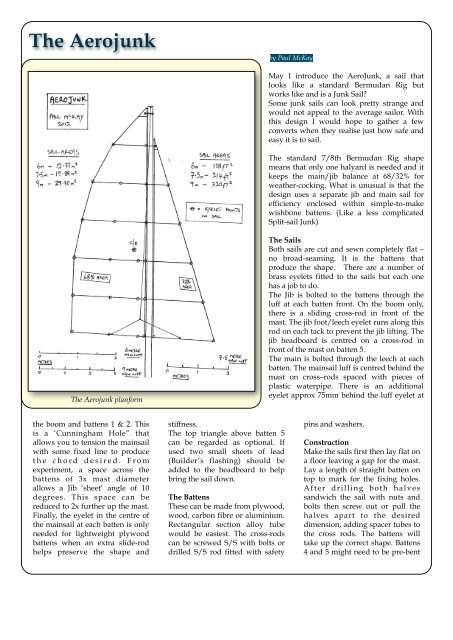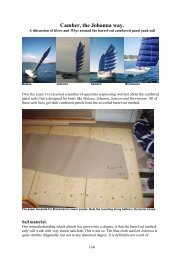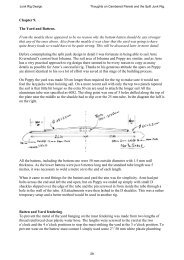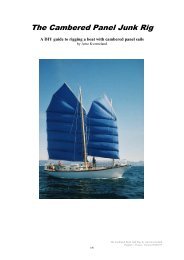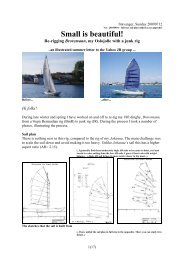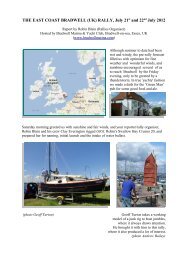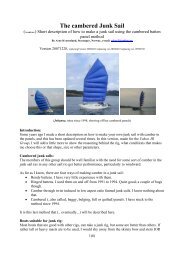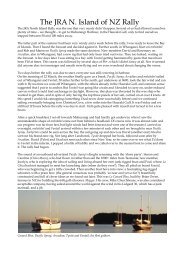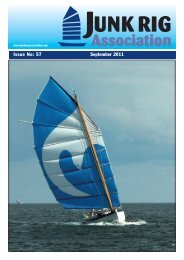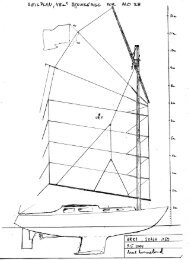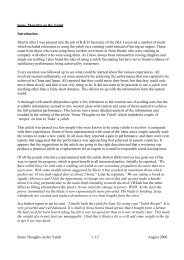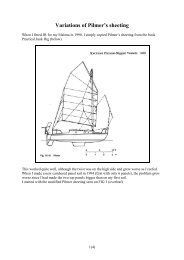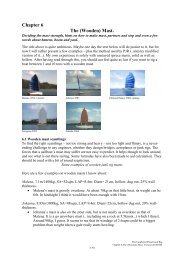The Aerojunk - The Junk Rig Association
The Aerojunk - The Junk Rig Association
The Aerojunk - The Junk Rig Association
Create successful ePaper yourself
Turn your PDF publications into a flip-book with our unique Google optimized e-Paper software.
<strong>The</strong> <strong>Aerojunk</strong><br />
by Paul McKay<br />
May I introduce the Aero<strong>Junk</strong>, a sail that<br />
looks like a standard Bermudan <strong>Rig</strong> but<br />
works like and is a <strong>Junk</strong> Sail?<br />
Some junk sails can look pretty strange and<br />
would not appeal to the average sailor. With<br />
this design I would hope to gather a few<br />
converts when they realise just how safe and<br />
easy it is to sail.<br />
<strong>The</strong> standard 7/8th Bermudan <strong>Rig</strong> shape<br />
means that only one halyard is needed and it<br />
keeps the main/jib balance at 68/32% for<br />
weather-cocking. What is unusual is that the<br />
design uses a separate jib and main sail for<br />
efficiency enclosed within simple-to-make<br />
wishbone battens. (Like a less complicated<br />
Split-sail <strong>Junk</strong>)<br />
<strong>The</strong> <strong>Aerojunk</strong> planform<br />
<strong>The</strong> Sails<br />
Both sails are cut and sewn completely flat –<br />
no broad-seaming. It is the battens that<br />
produce the shape. <strong>The</strong>re are a number of<br />
brass eyelets fitted to the sails but each one<br />
has a job to do.<br />
<strong>The</strong> Jib is bolted to the battens through the<br />
luff at each batten front. On the boom only,<br />
there is a sliding cross-rod in front of the<br />
mast. <strong>The</strong> jib foot/leech eyelet runs along this<br />
rod on each tack to prevent the jib lifting. <strong>The</strong><br />
jib headboard is centred on a cross-rod in<br />
front of the mast on batten 5.<br />
<strong>The</strong> main is bolted through the leech at each<br />
batten. <strong>The</strong> mainsail luff is centred behind the<br />
mast on cross–rods spaced with pieces of<br />
plastic waterpipe. <strong>The</strong>re is an additional<br />
eyelet approx 75mm behind the luff eyelet at<br />
the boom and battens 1 & 2. This<br />
is a ‘Cunningham Hole” that<br />
allows you to tension the mainsail<br />
with some fixed line to produce<br />
the chord desired. From<br />
experiment, a space across the<br />
battens of 3x mast diameter<br />
allows a Jib ‘sheet’ angle of 10<br />
degrees. This space can be<br />
reduced to 2x further up the mast.<br />
Finally, the eyelet in the centre of<br />
the mainsail at each batten is only<br />
needed for lightweight plywood<br />
battens when an extra slide-rod<br />
helps preserve the shape and<br />
stiffness.<br />
<strong>The</strong> top triangle above batten 5<br />
can be regarded as optional. If<br />
used two small sheets of lead<br />
(Builder’s flashing) should be<br />
added to the headboard to help<br />
bring the sail down.<br />
<strong>The</strong> Battens<br />
<strong>The</strong>se can be made from plywood,<br />
wood, carbon fibre or aluminium.<br />
Rectangular section alloy tube<br />
would be easiest. <strong>The</strong> cross-rods<br />
can be screwed S/S with bolts or<br />
drilled S/S rod fitted with safety<br />
pins and washers.<br />
Construction<br />
Make the sails first then lay flat on<br />
a floor leaving a gap for the mast.<br />
Lay a length of straight batten on<br />
top to mark for the fixing holes.<br />
After drilling both halves<br />
sandwich the sail with nuts and<br />
bolts then screw out or pull the<br />
halves apart to the desired<br />
dimension, adding spacer tubes to<br />
the cross rods. <strong>The</strong> battens will<br />
take up the correct shape. Battens<br />
4 and 5 might need to be pre-bent
ecause of their short length.<br />
<strong>Rig</strong>ging<br />
For a stepped mast fit the jib luff bolts (and jib<br />
slide rod) with wingnuts. This allows for easy<br />
fitting and removal round the mast. <strong>The</strong><br />
halyard uses a standard 3:1 purchase and the<br />
sheet runs via sheetlets as normal. ‘Lazy<br />
Jacks’ are fitted to the boom as normal. <strong>The</strong><br />
mainsail headboard is tethered round the<br />
mast by parrel beads. <strong>The</strong>re is no need for any<br />
additional adjustment or hauling ropes.<br />
Performance<br />
On either tack the whole rig hangs to leeward<br />
leaving both sails clear of mast interference.<br />
Each sail takes up the curvature of the batten<br />
and the jib ‘sets’ itself to a sheet angle of<br />
about 10 degrees providing the ‘slot’ that<br />
accelerates air past the main. <strong>The</strong> sheet angle<br />
can be reduced by fitting stoppers on the slide<br />
rod. <strong>The</strong> Centre of Effort remains inboard<br />
close to the mast on all points of sail thus<br />
reducing rudder drag. As with all junks, it is<br />
soft-gybing and the whole sail can be let out<br />
to 90 degrees downwind for better<br />
performance. Finally, the sail is reefed with<br />
the halyard by dropping one batten at a time<br />
into the lazyjacks.<br />
Paul McKay 2012<br />
David Tyler<br />
Twisty full sails, close-reaching in very light air, with<br />
camber enough


